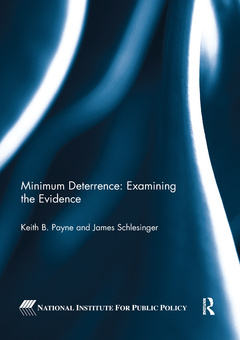Minimum Deterrence: Examining the Evidence
Auteurs : Payne Keith B., Schlesinger James

The National Institute for Public Policy?s new book, Minimum Deterrence: Examining the Evidence, is the first of its kind. Dr. Keith Payne, the late former Secretary of Defense James Schlesinger and an unparalleled bipartisan group of senior civilian and military experts critically examined eight basic assumptions of Minimum Deterrence against available evidence. In general, Minimum Deterrence does not fare well under the careful scrutiny.
Proponents of a "Minimum Deterrent" US nuclear force posture believe that anywhere from a handful to a few hundred nuclear weapons are adequate to deter reliably and predictably any enemy from attacking the United States now and in the future. Because nuclear weapons are so destructive, their thinking goes, no foreign leader would dare challenge US capabilities. The benefits, advocates claim, of reducing US nuclear weapons to the "minimum" level needed are: better relations with Russia and China, reinforcement of the arms control and Nonproliferation Treaty, billions of defense dollars in savings, and greater international stability on the way to "nuclear zero."
As political pressure builds to pursue this vision of minimum US deterrence, Minimum Deterrence: Examining the Evidence stands as the seminal study to address the many claims of great benefit against available empirical evidence.
This book was published as a National Institute Press monograph, Keith B. Payne and James Schlesinger, Minimum Deterrence: Examining the Evidence (Fairfax, VA: National Institute Press, 2013) and as a special issue of Comparative Strategy.
Preface Executive Summary I. Introduction: Minimum Deterrence II. Minimum Deterrence and U.S. Policy III. Minimum Deterrence: Assumptions, Logic and Conclusions IV. Examining and Testing the Fundamental Assumptions and Logic of Minimum Deterrence V. Summary and Conclusion: How Does Minimum Deterrence Fare Against Available Evidence and What Alternative Guidelines May Be Better? Notes Appendix
Keith B. Payne, Study Director; President, National Institute for Public Policy; Department Head, graduate school of Defense and Strategic Studies, Missouri State University (Washington, DC campus)
The Honorable James Schlesinger, Chairman, Senior Review Group, former Secretary of Defense; Secretary of Energy; Director of Central Intelligence; Chairman of the United States Atomic Energy Commission
Date de parution : 12-2020
17.4x24.6 cm
Date de parution : 11-2014
17.4x24.6 cm
Disponible chez l'éditeur (délai d'approvisionnement : 14 jours).
Prix indicatif 160,25 €
Ajouter au panierThème de Minimum Deterrence: Examining the Evidence :
Mots-clés :
nuclear; United States; Russia; China; Minimum Deterrence; Non-proliferation Treaty; Deep Nuclear Reductions; Nuclear Disarmament; Air Force Global Strike Command; WMD Terrorism; Low Force Levels; Nuclear Reductions; Dynamic Threat Environment; Nuclear Forces; Deterrence Requirements; Start Treaty



